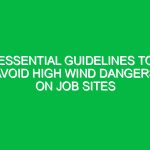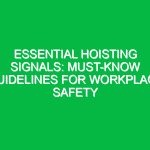“`html
Must-Know Guidelines for High Wind Dangers in Construction Sites
Good morning team,
Today, we’re going to discuss an important topic that affects our daily operations on the construction site: the dangers posed by high winds. Understanding these dangers is crucial for ensuring our safety and preventing accidents. High winds can turn a construction site into a hazardous Environment, leading to injuries or even fatalities if proper Precautions are not taken. By the end of this Toolbox Talk, you will know how to recognize the risks associated with high winds and what steps to take to protect yourself and your coworkers.
Understanding High Wind Dangers
High wind dangers refer to the risks and Hazards associated with strong winds at construction sites. These can include flying debris, instability of equipment and structures, and reduced visibility. It’s essential to understand that high winds can cause significant disruptions in our work and lead to dangerous situations if not properly managed.
Many workers may think that high winds are a minor concern, but the reality is that strong gusts can lead to serious accidents. For instance, loose materials can be blown off roofs or scaffolding, posing a risk to anyone below. Additionally, equipment like cranes and lifts can become unstable, leading to catastrophic failures.
Key Hazards, Risks, and Safety Considerations
- Flying Debris: Loose materials can become projectiles, injuring workers or damaging property.
- Equipment Instability: High winds can affect the balance and Operation of cranes, scaffolding, and other heavy machinery.
- Reduced Visibility: Dust and debris stirred up by wind can obscure visibility, increasing the risk of accidents.
- Structural Damage: Wind can compromise temporary structures, creating dangerous collapse risks.
Ignoring these hazards can lead to severe consequences. There have been cases where construction sites experienced significant accidents due to high winds, resulting in injuries, property damage, and even loss of life. As safety professionals, we must prioritize understanding these risks to prevent such incidents.
Best Practices, Procedures, & Actionable Advice
Step-by-Step Safety Procedures
To ensure safety on days with high wind predictions, follow these essential procedures:
- Monitor Weather Conditions: Always check weather forecasts and stay updated on wind conditions. If high winds are predicted, prepare your site accordingly.
- Secure Loose Materials: Ensure all materials and equipment are secured to prevent them from being blown away. Use weight, tie-downs, or enclosures where necessary.
- Implement Temporary Site Shutdowns: If wind speeds exceed safe working limits (typically around 20 mph, but refer to your specific site’s Safety Guidelines), consider halting work until conditions improve.
- Communicate with Your Team: Make sure everyone on site is aware of the wind conditions and safety procedures. Conduct safety briefings regularly.
- Use Personal Protective Equipment (PPE): Ensure that everyone wears hard hats, safety glasses, and other necessary protective gear, especially on windy days.
For example, in a recent project, a crew faced high winds while working on a roof. They secured all materials and temporarily halted work, which prevented potential injuries. This incident highlights the importance of adhering to safety protocols.
Regulations, Standards, and Compliance
Compliance with safety Regulations is paramount to ensure a safe working environment. The Occupational Safety and Health Administration (OSHA) has specific guidelines regarding working in adverse weather conditions, including high winds. Adhering to these guidelines not only protects you but also ensures that our company remains compliant with federal regulations.
Always follow your company’s safety protocols and remember that compliance is not just about avoiding fines; it’s about safeguarding lives.
Employee Engagement & Discussion
Now that we’ve covered the guidelines and Best Practices, let’s open the floor for discussion. What safety challenges have you encountered related to high winds? Have there been any past experiences where you felt unsafe due to wind conditions? Your input could help us improve our Safety Measures.
Conclusion & Key Takeaways
In summary, high winds pose significant dangers at construction sites, and it is essential to be proactive in managing these risks. Remember to monitor weather conditions, secure materials, communicate effectively, and always prioritize safety compliance. By following these guidelines, we can help ensure that everyone goes home safely at the end of the day.
Thank you for your attention and commitment to safety. Let’s make sure we take these Precautions seriously and look out for one another.
“`


